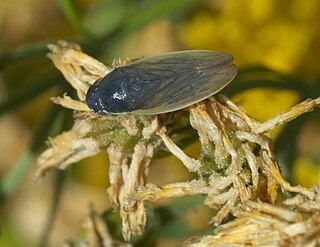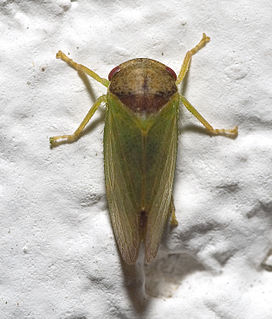Moçambola is the top division of Mozambican football. It is organized by the Liga Moçambicana de Futebol.

Pyramidellidae, common name the pyram family, or pyramid shells, is a voluminous taxonomic family of mostly small and minute ectoparasitic sea snails, marine heterobranch gastropod molluscs. The great majority of species of pyrams are micromolluscs.

Hybotidae, the typical dance flies, are a family of true flies. They belong to the superfamily Empidoidea and were formerly included in the Empididae as a subfamily.

Planorbidae, common name the ramshorn snails or ram's horn snails, is a family of air-breathing freshwater snails, aquatic pulmonate gastropod molluscs. Unlike most molluscs, the blood of ram's horn snails contains iron-based hemoglobin instead of copper-based hemocyanin. As a result, planorbids are able to breathe oxygen more efficiently than other molluscs. The presence of hemoglobin gives the body a reddish colour. This is especially apparent in albino animals.

Physidae, common name the bladder snails, is a monophyletic taxonomic family of small air-breathing freshwater snails, aquatic pulmonate gastropod molluscs in the superfamily Lymnaeoidea.

The Pyralinae are the typical subfamily of snout moths and occur essentially worldwide, in some cases aided by involuntary introduction by humans. They are rather rare in the Americas however, and their diversity in the Australian region is also limited. Altogether, this subfamily includes about 900 described species, but new ones continue to be discovered. Like many of their relatives in the superfamily Pyraloidea, the caterpillar larvae of many Pyralinae – and in some cases even the adults – have evolved the ability to use unusual foods for nutrition; a few of these can become harmful to humans as pests of stored goods.

Deltocephalinae is a subfamily of leafhoppers. Deltocephalinae is the largest subfamily in the family Cicadellidae and is divided into 40 tribes, comprising over 925 genera, and over 6,700 described species.

Phylinae is a subfamily of the plant bug family Miridae. Species of this family are found worldwide.
Philippine Studies: Historical and Ethnographic Viewpoints is a quarterly peer-reviewed academic journal covering research on the history and ethnography of the Philippines and its peoples. It is published by the Ateneo de Manila University and was established by Leo A. Cullum in 1953 as Philippine Studies, obtaining its subtitle in 2012. The editor-in-chief is Filomeno V. Aguilar, Jr. Issues can be accessed via its website, the university's journals portal, and other online databases such as JSTOR and Project MUSE.

Dipsadinae is a large subfamily of colubroid snakes, sometimes referred to as a family (Dipsadidae). They are found in most of the Americas, including the West Indies, and are most diverse in South America. There are more than 700 species.
Typhlocybini is a leafhopper tribe in the subfamily Typhlocybinae.

Athysanini is a tribe of leafhoppers in the subfamily Deltocephalinae. The type genus of the tribe is Athysanus. The tribe has a cosmopolitan distribution. It is the largest tribe in the subfamily Deltocephalinae and has 228 genera and at least 1120 species.

Deltocephalini is a tribe of leafhoppers in the subfamily Deltocephalinae. Deltocephalini contains 72 genera and more than 600 species.

Gyponini is a tribe of leafhoppers in the family Cicadellidae, formerly treated as a subfamily, but now considered to belong within the subfamily Iassinae. Gyponini includes about 60 genera and more than 1,300 described species, located in the Americas.

Iassinae is a subfamily of leafhoppers in the family Cicadellidae.

Evacanthinae is a subfamily in the family Cicadellidae (leafhoppers).
Mileewinae is a small subfamily in the family Cicadellidae (leafhoppers). It is closely related to Typhlocybinae and contains species that were previously part of Cicadellinae.
Bahitini is a tribe of leafhoppers in the subfamily Deltocephalinae. Bahitini contains 25 genera and over 165 species.
Paralimnini is a tribe of leafhoppers in the subfamily Deltocephalinae. Paralimnini contains 139 genera and over 900 species divided into two subtribes: Aglenina and Paralimnina. The tribe has a cosmopolitan distribution.













